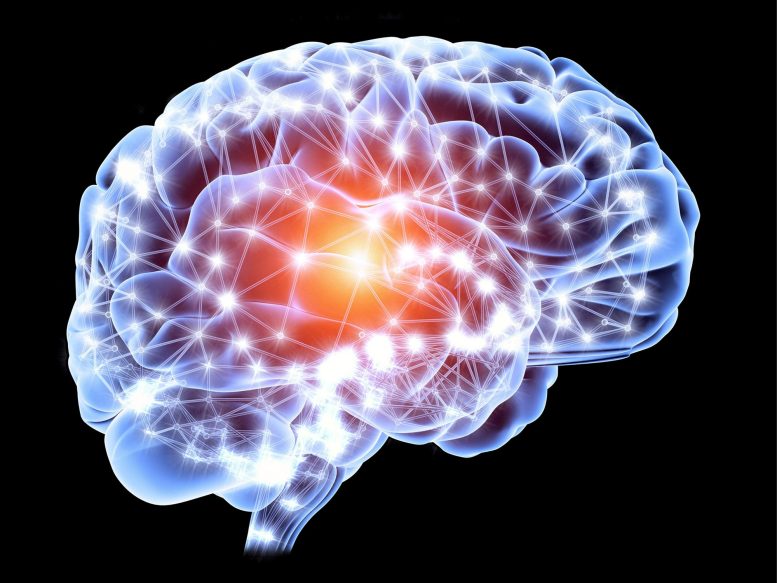
The team identified a brain network that is common for all psychiatric illnesses. This discovery opens up new opportunities for future research, such as looking at brain scans to see if the same circuit is active and comparing differences between psychiatric disorders using this circuit.
The study utilized several existing datasets to explore the neural basis of various psychiatric disorders and discovered a common network for all of them.
Nearly one in five adults in the United States is affected by psychiatric disorders such as schizophrenia and depression. Additionally, about half of patients diagnosed with a psychiatric illness also have symptoms of another disorder. This overlap has led researchers to believe that there may be a single neurobiological explanation for various psychiatric illnesses.
A team of researchers from Brigham and Women’s Hospital, a member of the Mass General Brigham healthcare system, studied four existing neurological and psychiatric datasets and pinpointed a network of brain areas underlying psychiatric illnesses. The results of the study were recently published in the journal Nature Human Behavior.
“Traditionally, neurology and psychiatry have different diagnostic strategies,” said corresponding author Joseph J. Taylor, MD, Ph.D., Medical Director of Transcranial Magnetic Stimulation at the Brigham’s Center for Brain Circuit Therapeutics and an associate psychiatrist in the Brigham’s Department of Psychiatry.
“Neurology asks: ‘Where is the lesion?’ and psychiatry asks: ‘What are the symptoms?’ We now have tools to explore the ‘where’ question for psychiatry disorders. In this study, we examined whether psychiatric disorders share a common brain network.”
The researchers began by analyzing a set of structural brain data from over 15,000 healthy controls as well as patients diagnosed with schizophrenia, bipolar disorder, depression, addiction, obsessive-compulsive disorder, or anxiety. They found gray matter decreases in anterior cingulate and insula, two brain regions commonly associated with psychiatric illness. However, only a third of studies showed gray matter decreases in these brain regions. Additionally, neurodegenerative diseases also showed gray matter decreases in these same regions.
To address these shortcomings, the team used the human connectome (a wiring diagram of the human brain) to test whether gray matter changes in psychiatric illness more effectively mapped to a common brain network than they did to common brain regions. The researchers discovered a transdiagnostic network in which up to 85 percent of studies showed gray matter decreases. This network was specific to gray matter decreases in psychiatric versus neurodegenerative disorders. They then conducted the same analyses while leaving out data from one psychiatric diagnosis at a time. The transdiagnostic network remained robust, suggesting that no single psychiatric illness was disproportionately responsible for the network they identified.
In subsequent analyses of a dataset including brain imaging from 194 veterans with and without penetrating head trauma along with their psychiatric diagnoses, the researchers overlayed lesions onto the transdiagnostic network and found that lesion-induced damage in the network correlated with a higher likelihood of multiple psychiatric illnesses. They also used the veteran data to independently derive a transdiagnostic network based on brain lesions associated with psychiatric illness. They found that this lesion-based psychiatric network was very similar to their atrophy-based psychiatric network despite having been derived from a completely different dataset.
Finally, the team used data from neurosurgical ablations for patients with extreme and otherwise untreatable psychiatric illnesses. These ablation targets aligned with the transdiagnostic network.
Most surprisingly, said Taylor, their findings seem to challenge the idea that gray matter decreases in the anterior cingulate and insula are causally related to psychiatric illness. “We found that lesions to those regions were correlated with less psychiatric illness, not more, so atrophy in that cingulate and insula may be a consequence or a compensation for psychiatric illness rather than a cause of it,” said Taylor. Instead, their analyses point to the posterior parietal cortex as the brain network node most likely to be causally associated with psychiatric illness.
By identifying a significant, sensitive, and specific transdiagnostic network for psychiatric illness, the team has opened up a number of possible new directions for follow-up studies, including analyzing existing fMRI datasets to see if neural activation patterns follow the same circuit and investigating circuit-based differences across psychiatric disorders. Taylor also plans on using Transcranial Magnetic Stimulation (TMS) to modulate the network, specifically using the posterior parietal region as a target.
“Psychiatric disorders are brain disorders, and now we’re just beginning to have the tools to study and modulate their underlying circuitry,” said Taylor. “There may be more in common across these disorders than we originally thought.”
Reference: “A transdiagnostic network for psychiatric illness derived from atrophy and lesions” by Joseph J. Taylor, Christopher Lin, Daniel Talmasov, Michael A. Ferguson, Frederic L. W. V. J. Schaper, Jing Jiang, Madeleine Goodkind, Jordan Grafman, Amit Etkin, Shan H. Siddiqi, and Michael D. Fox, 12 January 2023, Nature Human Behaviour.
DOI: 10.1038/s41562-022-01501-9
Disclosures: JJT: none. CL: none, DT: none. MAF: none. FLWVJS: none. JJ: none. MG: none. JG: none. AE: salary and equity from Alto Neuroscience, and equity from Mindstrong Health and Akili Interactive. SS: Owner of intellectual property involving the use of brain connectivity to target TMS, scientific consultant for Magnus Medical, investigator-initiated research funding from Neuronetics and Brainsway, speaking fees from Brainsway and Otsuka (for PsychU.org), shareholder in Brainsway (publicly traded) and Magnus Medical (not publicly traded). None of these entities were directly involved in the present work. MDF: Scientific consultant for Magnus Medical, owns independent intellectual property involving the use of functional connectivity to target TMS. This intellectual property was not used in the present manuscript.









Be the first to comment on "Scientists Discover Common Brain Network for Psychiatric Illnesses"